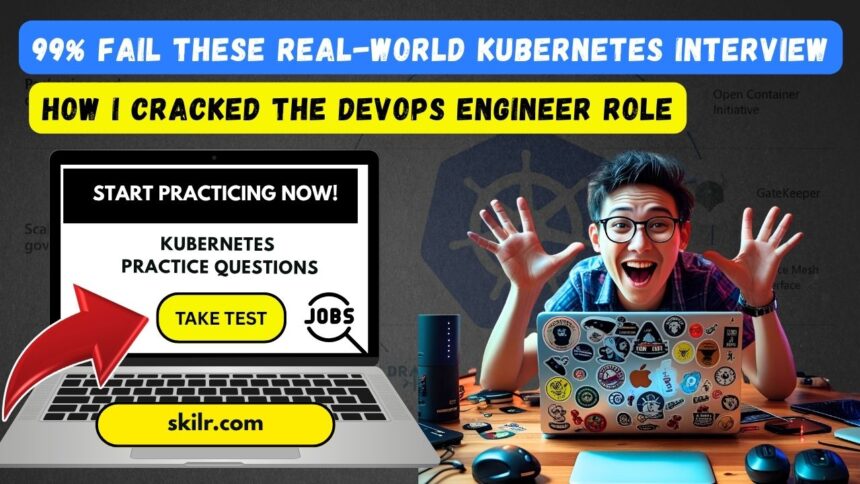Kubernetes, often referred to as K8s, has emerged as the industry standard for container orchestration, enabling the deployment, scaling, and management of containerized applications across diverse environments. Cracking the Kubernetes Interview is becoming increasingly challenging! Developed by Google and now maintained by the Cloud Native Computing Foundation (CNCF), Kubernetes automates many of the manual processes involved in managing containers, making it an essential tool for DevOps teams and cloud-native development.
With the rapid adoption of microservices architectures and hybrid or multi-cloud strategies, proficiency in Kubernetes has become a highly sought-after skill in the technology job market. This blog compiles the Top 50 Kubernetes interview questions and answers, ranging from fundamental concepts to advanced, scenario-based problem-solving. It aims to help professionals prepare thoroughly, gain confidence, and demonstrate expertise in real-world Kubernetes environments.
Target Audience
This blog is designed for professionals, learners, and technology enthusiasts who want to strengthen their understanding of Kubernetes and prepare for interviews with confidence. It will be especially useful for:
- DevOps Engineers seeking to validate their container orchestration skills and prepare for Kubernetes-focused interviews.
- Cloud Engineers and Administrators managing Kubernetes clusters in production or hybrid cloud environments.
- Software Developers building microservices and containerized applications who want to understand Kubernetes deployment and scaling.
- IT Professionals transitioning to Cloud-Native roles who need a comprehensive yet structured guide to Kubernetes concepts.
- Students and beginners aiming to build a strong foundation in Kubernetes to enhance their career prospects.
Whether you are a beginner aiming to break into DevOps or a seasoned professional preparing for complex technical discussions, this compilation offers an organized and practical approach to mastering Kubernetes interview questions.
Section 1: Kubernetes Basics (Questions 1–10)
1. What is Kubernetes?
Answer: Kubernetes is an open-source container orchestration platform that automates the deployment, scaling, and management of containerized applications. It helps ensure high availability, scalability, and efficient resource utilization across different environments.
2. Who developed Kubernetes, and who maintains it now?
Answer: Kubernetes was originally developed by Google, based on its internal Borg system. It is now maintained by the Cloud Native Computing Foundation (CNCF).
3. What problems does Kubernetes solve?
Answer: Kubernetes addresses challenges in deploying, scaling, and managing containers by automating tasks such as load balancing, service discovery, scaling, self-healing, and rolling updates.
4. What is the difference between Kubernetes and Docker?
Answer: Docker is a platform for building and running containers, whereas Kubernetes is an orchestration system that manages and coordinates multiple containers across clusters. Docker focuses on containerization; Kubernetes focuses on managing those containers at scale.
5. What are Pods in Kubernetes?
Answer: A Pod is the smallest deployable unit in Kubernetes, containing one or more tightly coupled containers that share the same network namespace and storage.
6. What are Nodes in Kubernetes?
Answer: Nodes are the worker machines (virtual or physical) in a Kubernetes cluster where Pods are scheduled to run. Each node contains the container runtime, kubelet, and networking components.
7. What is a Kubernetes cluster?
Answer: A Kubernetes cluster is a set of nodes (workers) managed by a control plane. The control plane schedules workloads, manages resources, and ensures the desired state of applications.
8. What is the role of the kubelet?
Answer: The kubelet is an agent running on each node that communicates with the Kubernetes API server. It ensures containers in a Pod are running and healthy.
9. What is kubectl?
Answer: kubectl is the command-line tool used to interact with a Kubernetes cluster. It allows users to deploy applications, inspect resources, manage configurations, and troubleshoot workloads.
10. What is the default container runtime used in Kubernetes?
Answer: As of Kubernetes v1.24, the default container runtime is containerd, replacing Docker as the default runtime while still supporting Docker-built images.
Section 2: Kubernetes Architecture & Components (Questions 11–20)
11. What is the Kubernetes control plane?
Answer: The control plane is the central management layer of Kubernetes that makes global decisions about the cluster. It includes components such as the API server, etcd, controller manager, and scheduler.
12. What is the role of the API server in Kubernetes?
Answer: The API server acts as the main entry point for all Kubernetes commands. It exposes the Kubernetes API, processes REST requests, and updates the cluster state in etcd.
13. What is etcd in Kubernetes?
Answer: etcd is a distributed key-value store used by Kubernetes to store cluster configuration and state data reliably and consistently.
14. What is the function of the controller manager?
Answer: The controller manager runs various controllers that monitor the state of the cluster and take actions to move it toward the desired state, such as creating Pods when Deployments require them.
15. What is the Kubernetes scheduler?
Answer: The scheduler assigns newly created Pods to appropriate nodes based on resource availability, constraints, and scheduling policies.
16. What is kube-proxy?
Answer: kube-proxy is a network component that runs on each node. It maintains network rules to allow communication between services and Pods, handling load balancing within the cluster.
17. What are Namespaces in Kubernetes?
Answer: Namespaces provide a way to divide cluster resources between multiple users or teams, offering isolation and resource organization within the same cluster.
18. What is a ReplicaSet in Kubernetes?
Answer: A ReplicaSet ensures that a specified number of identical Pods are running at all times. It replaces any failed or terminated Pods automatically.
19. What is the difference between a Deployment and a ReplicaSet?
Answer: A Deployment manages ReplicaSets and provides declarative updates to Pods. While ReplicaSets maintain Pod counts, Deployments add version control and rolling updates.
20. What is a DaemonSet in Kubernetes?
Answer: A DaemonSet ensures that a copy of a specific Pod runs on all (or some) nodes in the cluster. It is commonly used for cluster-wide services like logging or monitoring agents.
Section 3: Deployments, Networking & Storage (Questions 21–30)
21. What is a Deployment in Kubernetes?
Answer: A Deployment is a higher-level Kubernetes object that manages ReplicaSets and Pods, enabling rolling updates, rollbacks, and declarative application management.
22. What is a StatefulSet in Kubernetes?
Answer: A StatefulSet manages the deployment of stateful applications. It ensures that Pods have a stable, unique identity and persistent storage across restarts.
23. What is the difference between a StatefulSet and a Deployment?
Answer: Deployments are used for stateless applications, where Pods can be replaced freely, while StatefulSets are designed for stateful applications that require consistent network identities and persistent data.
24. What is a Service in Kubernetes?
Answer: A Service is an abstraction that defines a logical set of Pods and provides a stable network endpoint for accessing them, enabling load balancing and service discovery.
25. What are the types of Services in Kubernetes?
Answer: The main Service types are ClusterIP (default, internal access only), NodePort (exposes services on node IPs), LoadBalancer (provisions external load balancers), and ExternalName (maps service to an external DNS name).
26. What is an Ingress in Kubernetes?
Answer: An Ingress is an API object that manages external access to services, typically HTTP/HTTPS, by providing routing rules and SSL termination capabilities.
27. What is a Persistent Volume (PV) in Kubernetes?
Answer: A Persistent Volume is a piece of storage in the cluster provisioned by an administrator or dynamically through storage classes, used to persist data beyond Pod lifecycles.
28. What is a Persistent Volume Claim (PVC) in Kubernetes?
Answer: A Persistent Volume Claim is a request by a user for storage. PVCs bind to PVs that match their requested capacity and access mode.
29. What is the difference between PV and PVC?
Answer: PV is the actual storage resource in the cluster, while PVC is a user’s request for storage. PVCs consume PVs based on matching specifications.
30. What is a StorageClass in Kubernetes?
Answer: A StorageClass defines the types of storage available in a cluster and allows dynamic provisioning of Persistent Volumes without manual configuration.
Section 4: Security, Monitoring & Scaling (Questions 31–40)
31. What is Role-Based Access Control (RBAC) in Kubernetes?
Answer: RBAC is a method for regulating access to Kubernetes resources based on the roles of individual users or service accounts, ensuring that users can only perform actions they are authorized for.
32. What is a Secret in Kubernetes?
Answer: A Secret is an object used to store and manage sensitive information such as passwords, tokens, or SSH keys, keeping them separate from application code and configuration files.
33. What is a ConfigMap in Kubernetes?
Answer: A ConfigMap stores non-sensitive configuration data as key-value pairs, allowing applications to be configured without altering container images.
34. What is NetworkPolicy in Kubernetes?
Answer: A NetworkPolicy defines how Pods communicate with each other and with external endpoints, allowing administrators to restrict traffic for security purposes.
35. How does Kubernetes support scaling applications?
Answer: Kubernetes supports both manual and automatic scaling through mechanisms like the Horizontal Pod Autoscaler (HPA), Vertical Pod Autoscaler (VPA), and Cluster Autoscaler.
36. What is the Horizontal Pod Autoscaler (HPA)?
Answer: The HPA automatically adjusts the number of Pods in a deployment based on observed CPU utilization or other custom metrics.
37. What is the Vertical Pod Autoscaler (VPA)?
Answer: The VPA automatically adjusts resource requests and limits for containers in a Pod to optimize performance and resource usage.
38. What is the Cluster Autoscaler?
Answer: The Cluster Autoscaler automatically adjusts the size of the Kubernetes cluster by adding or removing nodes based on workload demand.
39. What are some tools for monitoring Kubernetes clusters?
Answer: Common tools include Prometheus, Grafana, Kubernetes Dashboard, ELK Stack, and Datadog for real-time monitoring, logging, and performance visualization.
40. How can you secure a Kubernetes cluster?
Answer: Security can be enhanced through RBAC, enabling audit logging, restricting API server access, enforcing NetworkPolicies, using Secrets, regular patching, and scanning container images for vulnerabilities.
Section 5: Advanced & Scenario-Based Questions (Questions 41–50)
41. How does Kubernetes perform rolling updates?
Answer: Kubernetes performs rolling updates by gradually replacing old Pods with new ones while ensuring the application remains available. This process can be controlled using parameters such as maxUnavailable and maxSurge.
42. How can you roll back a deployment in Kubernetes?
Answer: You can roll back a deployment using the command kubectl rollout undo deployment <deployment-name>. This reverts the application to the previous stable state stored in the Deployment’s revision history.
43. What is a sidecar container pattern in Kubernetes?
Answer: The sidecar pattern involves deploying an additional container alongside the main application container within the same Pod to provide supporting functionality, such as logging, monitoring, or configuration updates.
44. How do you debug a failing Pod in Kubernetes?
Answer: Debugging steps include checking Pod logs with kubectl logs, describing the Pod with kubectl describe pod <pod-name>, verifying events, and using kubectl exec to access the container shell for inspection.
45. How would you handle a situation where a Node becomes NotReady?
Answer: First, check node status with kubectl get nodes, then inspect node events. Review kubelet logs, networking, and resource utilization. If required, cordon or drain the node and schedule workloads elsewhere.
46. How do you perform zero downtime deployments in Kubernetes?
Answer: Zero downtime deployments can be achieved through rolling updates, readiness probes, and configuring appropriate maxUnavailable and maxSurge values to keep the service available during updates.
47. What is a custom resource in Kubernetes?
Answer: A custom resource extends Kubernetes capabilities by allowing users to define their own resource types, managed via Custom Resource Definitions (CRDs).
48. What is the role of an Operator in Kubernetes?
Answer: An Operator automates the management of complex, stateful applications in Kubernetes by encoding domain-specific operational knowledge into custom controllers that act on CRDs.
49. How do you handle high availability for Kubernetes control plane components?
Answer: High availability is achieved by running multiple instances of control plane components (API server, etcd, controller manager, scheduler) across different nodes, often with load balancing and data replication.
50. How would you migrate workloads from one Kubernetes cluster to another?
Answer: Migration can be done using tools like Velero for backups and restores, exporting and applying manifests, or leveraging GitOps workflows to redeploy workloads in the target cluster.
Expert Corner
Kubernetes has become the cornerstone of modern application deployment and management, offering scalability, resilience, and flexibility for containerized workloads. Preparing for a Kubernetes interview requires a strong grasp of its core concepts, architecture, networking, storage, security, and advanced features. By understanding these 50 key questions and answers, candidates can confidently approach interviews and demonstrate practical knowledge along with problem-solving skills. Whether you are aiming for a role as a Kubernetes Administrator, DevOps Engineer, or Cloud Architect, mastering these topics will place you ahead in the competitive job market.





